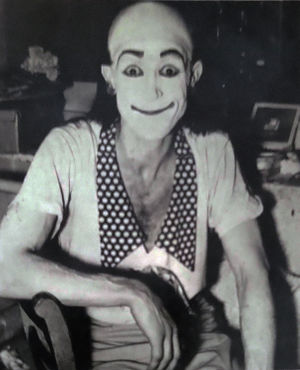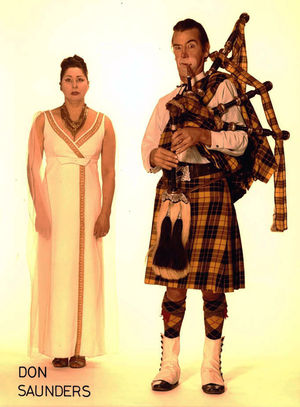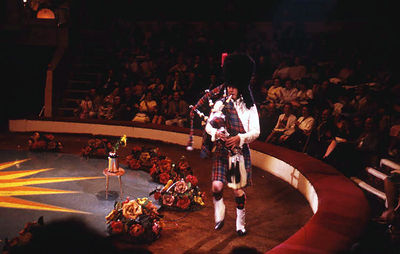Don Saunders
From Circopedia
Clown
By Dominique Jando
Don Saunders (1920-1981) is considered one of the most talented clowns of the mid-twentieth century. His style was very visual, though music played an important role in his act. Although his recognizable silhouette remained the same, his makeup was constantly simplified over the years, until it disappeared completely after Gilles Margaritis, the producer of the long-running French television show ''La Piste aux Étoiles'' and himself a former circus and variety performer (with a legendary musical act in which no music was ever played), suggested that he dispense with his clown makeup altogether—which Saunders did: indeed, he didn't need it.
Beginnings
He was born Donald Oliver Saunders in Hastings, on the south coast of England, on May 3, 1920, in a family that had no connection with the circus world. His parents wanted him to pursue a musical career—which he did eventually, but probably not in the form or in the places they expected! What truly attracted Donald was comedy, for which he had a natural talent, and more precisely the type of visual comedy that was performed in the circus or on the music-hall stages.He was seventeen, in the summer of 1937, when he made his debut as a musical clown at the Hippodrome Theatre, the main variety stage of Eastbourne, a popular seaside resort south of Hastings. His stage name was Chico, and early photographs suggest that he originally chose a whiteface makeup à la Pierrot, but with the long hair that he will keep all along his career, and the bald top cap that he will wear in his early years.
His first inspiration was Grock, the most famous musical clown of the era, and, later, Max Wall (1908-1990), a popular British music-hall comic whose "Professor Wallowsky," described by the British comedian Roy Hudd as a "lunatic, surreal pianist," was certainly a source of inspiration for Don's piano entrée(French) Clown piece with a dramatic structure, generally in the form of a short story or scene.. Yet, whoever may have inspired him, Don Saunders remained a true original, and a remarkably creative comedian.
Following his debuts, Don (the diminutive for Donald) toured extensively the British circus and variety circuit, albeit certainly not in a starring position. As a clownGeneric term for all clowns and augustes. '''Specific:''' In Europe, the elegant, whiteface character who plays the role of the straight man to the Auguste in a clown team., his physical appearance slowly evolved and his makeup, which, departing from whiteface, soon turned out to be comparable to Grock's relatively subtle maquillage, became increasingly more restrained. However, it was his gangling silhouette that truly defined him.
An International Career
In 1955, after his first engagement at the Hippodrome of Great Yarmouth (a popular summer circus in another well-known seaside resort), Don signed his first contract abroad with the illustrious Coliseu dos Recreios in Lisbon, Portugal, followed by an engagement at Madrid's no less distinguished Circo Price—a place where great clowns were appreciated by an audience of connoisseurs; now billed as Don Saunders, the success he obtained in Lisbon and Madrid a was significant enough to launch his international career.In 1957, Don Saunders made his first appearance in Paris at the Cirque d'Hiver, and the following year at was considered as the "Temple of Clowning," the fabled Cirque Medrano, in a show titled Rires à gogo ("Laughs Galore"). He spent the summers of 1958 and 1959 at the Great Yarmouth Hippodrome, where he will return in the summer of 1965. From 1961 to 1964, he will be featured in the touring seasons of Britain's premier circus, Bertram Mills, including the very last one in 1964. During the winter of 1962, he had returned to Circo Price in Madrid and, in 1963, he appeared twice on Gilles Margaritis's extremely popular French television show La Piste auxx Étoiles.
1965 was a fruitful year for Don Saunders: He made two important television appearances, first in the United States, on ABC TV's popular variety show Hollywood Palace (where he returned in 1966 with his piano entrée(French) Clown piece with a dramatic structure, generally in the form of a short story or scene.), then in Paris, where he returned to La Piste aux Étoiles at Paris's Cirque d'Hiver with his piano entrée(French) Clown piece with a dramatic structure, generally in the form of a short story or scene., wearing no makeup as Margaritis had suggested. He was also featured at the prestigious Cirkus Schumann in Copenhagen. Having discarded his clown makeup served it well: it opened to him the variety and cabaret stages, where he could be featured as a "musical eccentric" instead of a musical clownGeneric term for all clowns and augustes. '''Specific:''' In Europe, the elegant, whiteface character who plays the role of the straight man to the Auguste in a clown team..
Nonetheless, he didn't forsake his circus career; he returned to the Hippodrome of Great Yarmouth in the summer of 1966, then joined the Chipperfields Circus on a short tour in South Africa, toured with Billy Smart's Circus the following year, returned to the Cirque d'Hiver in 1969, and then toured in France with the Cirque Sabine Rancy. In 1971, he toured in Spain with Circo Atlas, owned by two legendary Spanish clowns, the Hermanos Tonetti.
Epilogue
Don Saunders was a soloist, but on stage he often used his wife Rina as a foil, a role in which her imposing, deadpan presence made a perfect contrast with her gesticulating and hapless husband. Don's humor, centered on the performance of musical instruments that were not always cooperating (not to mention the accompanying orchestra), made good use of misdirection to get laughter: the payoff of his visual comedy was generally not what was expected. His signature musical exit, for which he suddenly transformed himself into an improbable Scots Guard replete with kilt and bearskin and fought with a recalcitrant bagpipe, was nothing short of a little masterpiece.Don Saunders died in Paris, where he was living at the time, in early May 1981, at age sixty-one. His body was cremated, and his funeral was held on May 11, 1981, at the Columbarium of the Père Lachaise cemetery in Paris, where his ashes rest today, in the presence of many Parisian clowns who came to pay tribute to one of the most gifted funnymen of their time.
See Also
- Video: Don Saunders, musical entrée, in a television show (c.1960)
- Video: Don Saunders, clown entrée, on ABC Television's Hollywood Palace (1965)
- Video: Don Saunders, piano entrée, at the Cirque d'Hiver in Paris (1965)
- Video: Don Saunders, piano entrée, on ABC TV's Hollywood Palace (1966)









